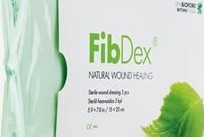 Wood-based FibDex® wound dressing can speed up healing and bring new convenience to patient care
Wood-based FibDex® wound dressing can speed up healing and bring new convenience to patient care
New wound care dressing made from a sustainable, wood-based raw material is particularly suited to treating large wound areas.
FibDex® is a new wound care product created by UPM in collaboration with researchers from the University of Helsinki and surgeons and nursing staff from the Helsinki Burn Centre. FibDex is the third biomedical product based on renewable and responsible wood-based raw materials to be commercialised by UPM.
Surgeons and nurses are really interested in the new product, which is more comfortable for patients and can speed up their recovery.
“Clinical trials showed the wound care dressing provides significant benefits for the treatment of skin graft donor sites”, says Dr Jane Spencer-Fry, Director of Biomedicals at UPM.
A biomedical innovation
The innovation was conceived when Marjo Yliperttula, Professor of Biopharmaceutics at the University of Helsinki, developed an interest in nanofibrillar cellulose. Yliperttula and her research team proved that nanofibrillar cellulose could be used for cell culture and wound care as well as various other applications.
“Skin grafts are used to treat severe burns, skin cancer and plastic surgeries. Skin is removed from the patient’s back, for example, and transplanted onto the part of the body needing treatment,” she explains.
Skin graft donor sites are very painful and can be difficult to heal. “The donor site must be dressed, but as the skin heals and grows, the new skin can stick to the dressing and peel away when the dressing is changed. This does not happen with FibDex as the dressing is only applied once at the start of treatment. During the healing process FibDex gradually peels away from the donor site once the skin beneath has healed,” notes Yliperttula.
Treating patients becomes easier
The dressing, made from nanofibrillar cellulose, provides a moist environment for optimal healing and absorbs fluids from the wound. Just one dressing is required throughout the whole treatment.
According to patients who took part in the clinical trial, FibDex was comfortable throughout treatment, but more importantly it was reported that there was a significant improvement in scar quality and vascularity.
“Changing burn patients’ wound dressings can be a very painful procedure, so both patients and nurses benefit from FibDex. It’s more comfortable for the patient and frees up nursing resources for other tasks,” adds Spencer-Fry.
Based on the clinical trial results, FibDex was awarded the CE mark, as it fulfils the standards and legislative requirements set for medical devices to be sold on the European market.
Aiming for global markets
As UPM’s products are newcomers to the biomedical and clinical applications markets, it will take a lot of work to increase recognition of both the company and its products. UPM is currently looking for partners to distribute the products.
“We are aiming for global markets. In addition to Europe, the product can be sold in in countries outside of the European Union which accept the European CE mark. The United States and China have different regulatory requirements,” says Spencer-Fry.
“Thanks to GrowDex® hydrogel for 3D cell culture, we have learnt how wood-based materials can benefit our customers, researchers and patients. We used this knowledge and expertise to our advantage when developing FibDex.”
Text: Vesa Puoskari
